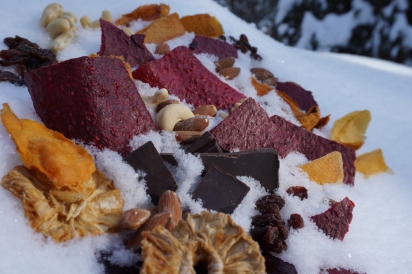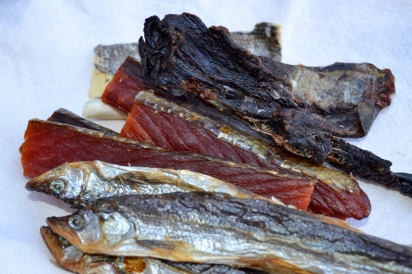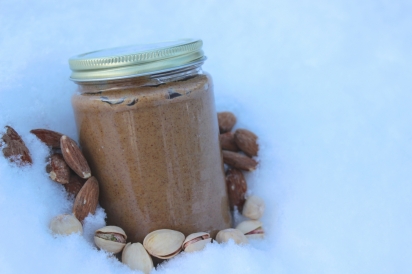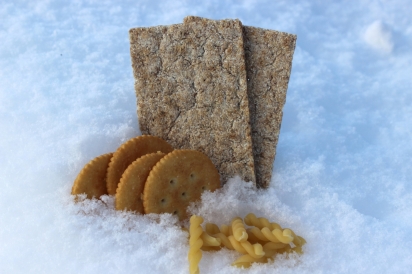Brr! The Best Bites for Subzero Temps
Years ago, I accepted a spontaneous invitation to go winter camping with a new friend I met in graduate school. Ryan was an unpredictable vegetarian, world-traveler from California. I was an omnivorous, ultralight thru-hiker living in Fairbanks. This outing would be the first winter camping experience in Interior Alaska for both of us.
We were fortunate it was not our last.
The day after Thanksgiving, Ryan gleefully showed up at my cabin, ready to go with a two-pound brick of cheese, a few avocados, and no tent. As we snowshoed under clear blue skies into the mountains near Cantwell, the temperatures dipped down to around 20 below zero. Frigid gusts smothered our attempts at a fire while the sun sank below the horizon. My toes felt like lifeless blocks as we piled fresh powder on spruce boughs for a shelter. Frozen and famished, we squeezed into our snow shelter.
Ryan’s avocados had frozen solid as did the water in our plastic bottles. We managed to chip chunks off the frozen cheddar with a knife, but it was like cracking our teeth on bits of rubbery ice. We had better luck with a bag of trail mix and my homemade fruit leather. Devoid of moisture and packed with flavor, these treats were perfectly edible at minus 20 degrees.
Over the years, mushers, hunters, trappers, and experienced winter adventurers have shared what foods are best for being outdoors in extreme temperatures. Pack these foods and tips for your next winter excursion.
Sweets
• “You’ll need simple sugars as tinder to get things going, quick fuel,” shared Deb Ajango, instructor and owner of Safety Education for Outdoor and Remote Work Environments. Candy, especially chocolate bars, falls into this category.
• Dried fruits are my go-to sweet source. Go basic and economical like raisins, fancy and exotic like dried mangos and pineapples, or local with homemade berry fruit leather.
Salmon strips and dried meat
• My Yup’ik and Inupiaq friends praise the nourishment of salmon strips, dry fish, and dried seal meat. Friends further south enjoy the oily abundance of dried hooligan, also known as candlefish.
• Village-style dry fish and salmon strips are the perfect combination of oily, flaky, and satisfying protein for winter. These timeless classics are worth every bit of effort in summer.
Bacon and fatty meat
• “It’s imperative to get warm quickly when we stop to set up camp because I’ve been skiing the whole day, so I’m really cold and sweaty,” explained Wendy Battino, an expedition skijorer from Talkeetna who treks several hundred miles for weeks at a time in the winter wilderness. “As soon as I stop to break camp, my routine is to get dry socks on and mukluks on, and then eat a piece of bacon or jerky. If it’s really cold when I get in my tent, I’ll pop in a piece of bacon before I sleep.”
Nuts and nut butters
• The homemade trail mix from my winter survival trip included a mixture of nuts, sesame sticks, chocolate, and dried fruit. Roasted nuts will add extra fuel to your revved up metabolism and salt will replenish electrolytes lost from sweating.
• “Pilot bread with a layer of Nutella and layer of pie filling was really good,” contributed 9-year-old Ida Bodony of Galena, who has gone winter camping in subzero temperatures with her family.
Seal oil
• Cyrus Harris is an Inupiaq hunter and traditional foods specialist at Maniilaq Association in Kotzebue. He shared his go-to foods for being out in winter. “I take frozen fish and frozen meat and a jar of seal oil,” he said.
• This vitamin-rich oil rendered from seal blubber stays soft and keeps a person warm. It is winter gold for my Yup’ik and Inupiaq friends from the Yukon-Kuskokwim Delta, Northwest Arctic, and the North Slope.
Carbs
• According to Deb Ajango, complex carbs and proteins are like sticks to fuel the internal fire. “Pastas and breads take a little longer to digest but will give you more energy,” she said
• Little Debbie oatmeal cream pies are failsafe,” wrote winter adventurer and science writer Ned Rozell of Fairbanks.
Fats
• “Last on the fire, you’ll have your log,” said Deb Ajango. “Those are your fats, to supply you energy for burning up to 6-8 hours.”
• “Over the years, we’ve seen a lot of interesting things in the drop bags for the Iditarod mushers, including butter chopped up and rolled in cocoa powder,” said Tim Bodony, whose family lives in Galena and volunteers when Iditarod mushers come through town.
Now that you know what to eat, here are some other things to keep in mind:
A little preparation goes a long way
Save time and the potential to get chilled by taking time to cut up solid items such as bacon, cheese, and sausage. Be mindful of packaging since opening cans and hauling garbage can be a burden in the cold. Sandwiches and burritos are filling and are soft enough to be edible when frozen and can be eaten with mittens on.
Pack hot liquids in an insulated container
The risk for dehydration is higher in cold temperatures, so invest in an insulated container. Brands like Thermos, Stanley, Yeti, and Hydroflask can keep liquids hot for hours. Hot water can be added to dehydrated foods for warm, comforting meals.
Keep things warm
Put lighters and food inside your coat or parka to keep from freezing or to thaw foods before eating.
Heat things up
Fires can be unreliable and slow-going, so it’s best to bring a heat source or stove that burns white gas if you choose to cook. “Our snow machines had a metal tin box (called a "hot-dogger") under the hood right next to the engine. Just toss in your lunch about 30 minutes before you need it,” said Dana Fjare, a field biologist who has trapped and collared lynx at temperatures around minus 30 degrees.
Eat for the occasion
“Have your high-energy snacks on hand for when it’s best to keep moving rather than risk stopping and getting chilled. Bring out heavier snacks like kippered snacks, meats, and carbs for when you really need to refuel. When you’re ready for a break and in a good spot to cook, take out the stove and heat up water to make soup,” said musher Karin Bodony, who lives with her family in Galena.
Think of food as fuel
Deb Ajango provides one final piece of advice. “You can be a health food addict during the week, but when you do activities outdoors in cold weather, those rules get thrown out the window. It’s more about getting the calories and fat that you need rather than healthy eating.”
Jennifer Nu is a freelance writer in Alaska. She can be reached by email.







